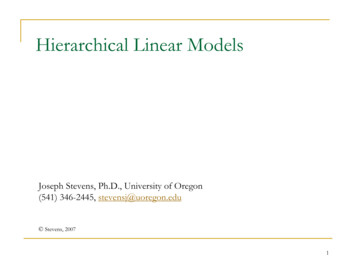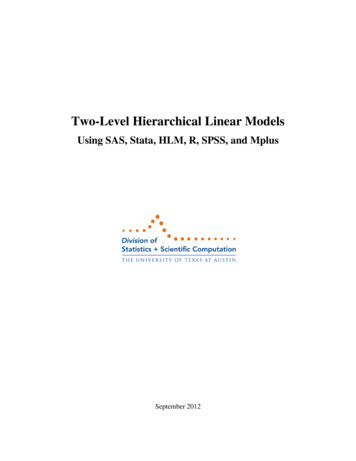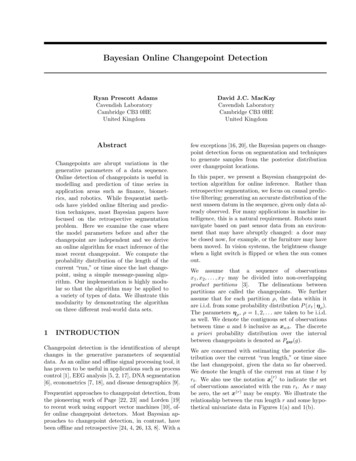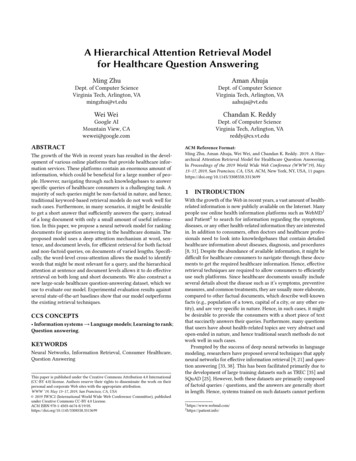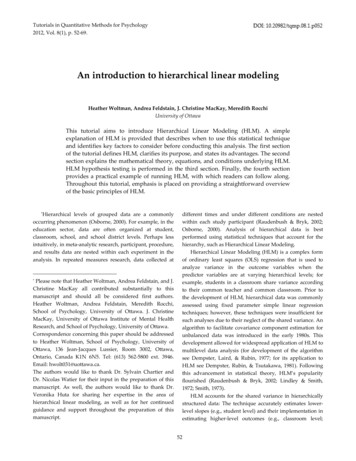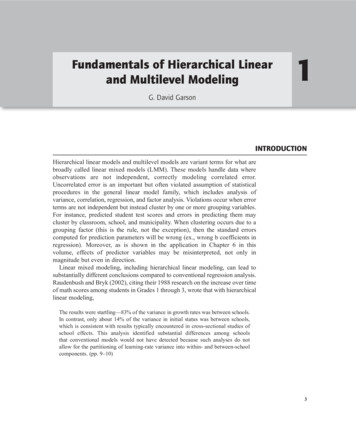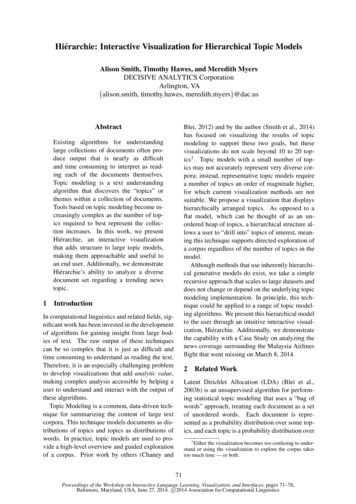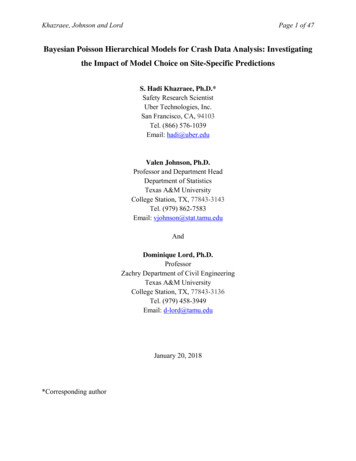
Transcription
Khazraee, Johnson and LordPage 1 of 47Bayesian Poisson Hierarchical Models for Crash Data Analysis: Investigatingthe Impact of Model Choice on Site-Specific PredictionsS. Hadi Khazraee, Ph.D.*Safety Research ScientistUber Technologies, Inc.San Francisco, CA, 94103Tel. (866) 576-1039Email: hadi@uber.eduValen Johnson, Ph.D.Professor and Department HeadDepartment of StatisticsTexas A&M UniversityCollege Station, TX, 77843-3143Tel. (979) 862-7583Email: vjohnson@stat.tamu.eduAndDominique Lord, Ph.D.ProfessorZachry Department of Civil EngineeringTexas A&M UniversityCollege Station, TX, 77843-3136Tel. (979) 458-3949Email: d-lord@tamu.eduJanuary 20, 2018*Corresponding author
Khazraee, Johnson and LordPage 1 of 47ABSTRACTThe Poisson-gamma (PG) and Poisson-lognormal (PLN) regression models are amongthe most popular means for motor vehicle crash data analysis. Both models belong to thePoisson-hierarchical family of models. While numerous studies have compared the overallperformance of alternative Bayesian Poisson-hierarchical models, little research has addressedthe impact of model choice on the expected crash frequency prediction at individual sites. Thispaper sought to examine whether there are any trends among candidate models predictions e.g.,that an alternative model’s prediction for sites with certain conditions tends to be higher (orlower) than that from another model. In addition to the PG and PLN models, this researchformulated a new member of the Poisson-hierarchical family of models: the Poisson-inversegamma (PIGam). Three field datasets (from Texas, Michigan and Indiana) covering a wide rangeof over-dispersion characteristics were selected for analysis.This study demonstrated that the model choice can be critical when the calibrated modelsare used for prediction at new sites, especially when the data are highly over-dispersed. For allthree datasets, the PIGam model would predict higher expected crash frequencies than would thePLN and PG models, in order, indicating a clear link between the models predictions and theshape of their mixing distributions (i.e., gamma, lognormal, and inverse gamma, respectively).The thicker tail of the PIGam and PLN models (in order) may provide an advantage when thedata are highly over-dispersed. The analysis results also illustrated a major deficiency of theDeviance Information Criterion (DIC) in comparing the goodness-of-fit of hierarchical models;models with drastically different set of coefficients (and thus predictions for new sites) may yieldsimilar DIC values, because the DIC only accounts for the parameters in the lowest (observation)level of the hierarchy and ignores the higher levels (regression coefficients).
Khazraee, Johnson and LordPage 2 of 47Key Words: Poisson hierarchical, Bayesian model, site-specific prediction, model choice,Poisson-inverse gamma
Khazraee, Johnson and LordPage 3 of 47INTRODUCTIONOver the past three decades, highway safety researchers have been concerned withdeveloping statistical models to predict motor vehicle crashes. The purpose of such models is torelate the frequency of crashes to the traffic, geometrical, and/or environmental characteristics ofhighway entities. A mass of published work in the field of crash data modeling has focused onevaluating the application of countless statistical models by comparing their goodness-of-fit(GOF) to field data sets. These studies seek to answer the question of “which model performsbetter?” Measuring the GOF of statistical models is not a straightforward task; researchers usemany different methods for assessing GOF. These methods can yield contradictory results indetermining which model performs best.Even if there was a consensus among researchers in employing a unique method for GOFassessment, the performance of different models would depend on the characteristics of the dataset to which they are fitted. Based on the model structure and application to a limited number ofdatasets, some studies have suggested that certain models are expected to perform better thanother specified models for data with certain characteristics. For example, Geedipally et al. (2012)noted that the heavy-tailed negative binomial-Lindley (NB-L) distribution is expected tooutperform the negative binomial model for datasets with abundant zero crash observations and along/heavy tail. While rules of thumb like the aforementioned may be valid, it is difficult topredict with certainty which model performs better before the models are actually fitted to thedata. Therefore, one must be very cautious when making conclusions of the type “one model isbetter than another” based on a comparison of the models’ GOF to a few data sets.GOF analyses in the literature of crash data modeling have been focused on the overall fitof a model to an entire dataset. An important question that has often been overlooked is “how are
Khazraee, Johnson and LordPage 4 of 47the site-specific predicted crash frequencies affected by model choice?” Can we find a trend inthe difference between the predicted crash frequencies of different models; e.g., that a model’sprediction for sites with certain conditions is higher (or lower) than that from a different model?This paper conducts such a microscopic analysis for three hierarchical-Poisson regressionmodels, including the two most popular models in crash data analysis, the Poisson-gamma andPoisson-lognormal models. We also examine a new model, the Poisson-Inverse Gamma (PIGam)model; note: the PIGam should not be confused with the Poisson-Inverse Gaussian (PIG) model,as detailed in Zha et al. (2016). The PIGam model was formulated and added to this study toinvestigate the potential benefit of having a long/heavy-tailed mixing distribution (i.e., inverseGamma) in handling data sets with unusually high crash count observations. Three crash datasets with a range of dispersion characteristics were used to compare the performance of thecandidate models.This research is concerned with the Bayesian estimation of Poisson-hierarchical models.The Bayesian structure of the models and the practical interpretation of the model parameters aredescribed in detail and distinguished from the traditional frequentist models. The models’predictions are compared at two levels: a) for sites in the dataset where an observed crash countis available, and b) for hypothetical new sites without an observed crash count. Rather thanconsidering several candidate models and employing the best one (based on GOF comparisons)for prediction, this study aims to add depth to our understanding of how the magnitude ofpredictions is influenced if each of the three considered models is selected.
Khazraee, Johnson and LordPage 5 of 47BACKGROUNDBecause crashes are random events and typically independent of one another, the Poissondistribution is the intuitive means to describe the randomness in crash counts. In practice,however, the Poisson is rarely an appropriate distribution because the crash data are often overdispersed (Poch and Mannering, 1996; Hauer, 2001; Mitra and Washington, 2006), meaning thatthe conditional variance of observed crash counts is greater than the mean, whereas the Poissondistribution is equi-dispersed (i.e., the mean equals the variance).The over-dispersion in crash count data is mainly attributed to the heterogeneity amongthe different sites (highway segments, intersections, etc.) where crash data is collected (Hauer,2001; Washington et al., 2010; Lord and Mannering, 2010; Mannering and Bhat, 2014;Mannering et al., 2016). Although the effect of some important factors (such as traffic volume)on the expected number (mean) of crashes is usually accounted for by a regression model, somedegree of heterogeneity is always believed to remain unobserved due to factors either unknownor known but hard to collect and include in the model. In addition, Lord et al. (2005) showed thatthe theory behind the fundamental crash process itself gives rise to over-dispersion. They arguedthat a crash count is the sum of a series of Bernoulli random variables, with each trialrepresenting a vehicle/driver going through a site with an un-equal probability of success (crash).These assumptions lead to an over-dispersed distribution of crash counts.To accommodate for possible over-dispersion in crash data, researchers have extensivelyused mixed-Poisson models, where crash counts are assumed to have a Poisson distribution witha variable mean that follows an underlying distribution often referred to as the mixingdistribution. Mixed-Poisson models are indeed hierarchical, where at the lowest level ofhierarchy, conditional on the mean, the observed crash counts are mutually independent and
Khazraee, Johnson and LordPage 6 of 47Poisson-distributed while at the second level, the unobservable mean of crash counts variesacross sites with an assumed probability distribution. Importantly, hierarchical Poisson modelsparticularly suit the theoretical nature of crash frequency data. Such conceptual suitability, oftenreferred to as “goodness-of-logic”, has been sacrificed for a better statistical goodness-of-fit(GOF) in a number of regression models proposed for crash data analysis (Miaou and Lord,2003).Two types of mixed-Poisson models have gained extensive attention among highwaysafety researchers: Poisson-gamma, and Poisson-lognormal:1) Poisson-Gamma (PG)When the Poisson parameter is assumed to have a gamma probability distribution, themixed-Poisson distribution will have a closed form probability density function (pdf) which turnsout to be that of the Negative Binomial (NB). The over-dispersion parameter (α) of the NBdistribution captures the unmodeled heterogeneity (Miaou and Lord, 2003). The value of thisparameter defines the relationship between the distribution mean and variance as Var(yi) E[yi] αE[yi]2. The simplicity of model fitting and parameter interpretation has made the Poissongamma/NB the most popular model in crash data analysis. In its classical applications, modelersestimated the parameters using the Maximum Likelihood Estimate (MLE) method (e.g. Maycockand Hall, 1984; Hauer et al., 1989; Bonneson and McCoy, 1993; Vogt and Bared, 1998).Recently, the Poisson-gamma models have also been estimated using Bayesian methods(Schluter et al., 1997; Miaou and Lord, 2003; Miaou and Song, 2005; Lord and MirandaMoreno, 2008).
Khazraee, Johnson and LordPage 7 of 472) Poisson-Lognormal (PLN)The Poisson-lognormal model results when the Poisson parameter is assumed to follow alognormal distribution. Unlike the Poisson-gamma model, the marginal distribution of thePoisson-lognormal model does not have a closed form and the model parameters cannot beestimated analytically using the Maximum Likelihood Estimates (MLE) method. Despite theavailability of Hinde’s (1982) numerical integration method to approximate the MLE parameters,the Poisson-lognormal safety performance models in the published studies have all beenestimated using the Bayesian approach. The Poisson-lognormal model is potentially moreflexible than the Poisson-gamma (Lord and Mannering, 2010) and the model has becomeincreasingly popular in crash data analysis over the past few years (Miaou et al., 2003; AgueroValverde and Jovanis, 2008; Aguero-Valverde, 2013). Highway safety researchers have alsoused multivariate Poisson-lognormal models to jointly model crash frequency by severity whileaccounting for the correlation among different severity levels (Park and Lord, 2007; Ma et al.,2008; El-Basyouny and Sayed, 2009).The MLE method has traditionally been used to estimate safety performance modelparameters. Nonetheless, the MLE method cannot be used straightforwardly when the marginallikelihood function is difficult to characterize, as in the case of the Poisson-lognormal model.Nonetheless, the development of such models and others with complex functional forms wasgreatly facilitated after the rediscovery of Markov Chain Monte Carlo (MCMC) simulationmethods (Tanner and Wong, 1987; Gelfand and Smith, 1990) for model estimation from theBayesian perspective. Unlike the traditional frequentist approach, the Bayesian approach tostatistics aims to estimate the probability distribution of model parameters using the informationin the observed data as well as the prior knowledge about model parameters. The drastic growth
Khazraee, Johnson and LordPage 8 of 47in the processing speed of personal computers and availability of Bayesian software programssuch as WinBUGS (Spiegelhalter et al., 2003) and MLwiN (Yang et al., 1999) has helpedsignificantly in the increasing popularity of Bayesian models.The fully (hierarchical) Bayesian (FB) estimation of safety performance models has beenexplored only in the last two decades (Schluter et al., 1997; Davis and Yang, 2001; Miaou andLord, 2003; Carriquiry and Pawlovich, 2004; Miaou and Song, 2005; Park and Lord, 2007;Daziano et al., 2013). Prior to FB models, however, the empirical Bayes (EB) method wasintroduced into the highway safety literature (Hauer and Persaud, 1983; Hauer, 1986, 1992). TheEB method basically uses the Bayes rule to combine the information from some referencepopulation (or results of a regression model) with the observed crash counts at a certain site toestimate the expected (long-term) mean of crashes. There is extensive documentation andapplication of the EB method in highway safety, especially in before-after studies to estimate theeffect of safety countermeasures (Hauer, 1997; Persaud, 1998; Harwood et al., 2002; Persaudand Lyon, 2007; Fitzpatrick and Park, 2009). EB methods have also been used for identificationof hotspot locations (Persaud et al., 1999; Heydecker and Wu, 2001; Miranda-Moreno et al.,2005; Lord and Park, 2008).The FB approach has a fundamental advantage over the MLE and EB methods; it takesinto account the uncertainty associated with model parameters and provides exact measures ofuncertainty (Miaou and Lord, 2003). In the MCMC metho
Uber Technologies, Inc. San Francisco, CA, 94103 Tel. (866) 576-1039 Email: hadi@uber.edu Valen Johnson, Ph.D. Professor and Department Head Department of Statistics Texas A&M University College Station, TX, 77843-3143 Tel. (979) 862-7583 Email: vjohnson@stat.tamu.edu And Dominique Lord, Ph.D. Professor Zachry Department of Civil Engineering Texas A&M University College Station, TX, 77843
